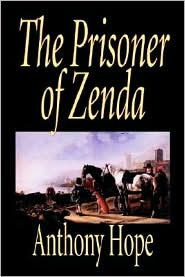

First published in 1894, Anthony Hope's novel The Prisoner of Zenda has been reworked, rewritten, stolen from, put on film, and made for television countless times. For some reason, Hope's tale of identical cousins, treachery, and adventure touches something in the cultural consciousness in the same manner as Shakespeare's plays or Dickens' novels, inspiring writers and filmmakers to come back to the tale again and again. The story of a commoner who discovers that he's a dead ringer for a king and is asked to impersonate him when the monarch has been kidnapped holds great appeal to common folk as a "what if…" scenario, in much the same way that we daydream about winning the lottery. Robert Heinlein used the story for his 1956 science fiction novel Double Star, setting the story on Mars. George Macdonald Fraser used Zenda as the basis for one of his "Flashman" series of books, which was made into a Richard Lester film, Royal Flash (1975) starring Malcolm MacDowell and Oliver Reed. Movies, in fact, have honored Zenda many, many times, from the subplot in Blake Edwards' The Great Race (1965) to Moon Over Parador (1988), in which Richard Dreyfuss plays an American who's a double for the president of a Caribbean nation, and Dave (1993), with Kevin Kline playing a double for the U.S. president. On its own, The Prisoner of Zenda has been adapted for movies and television at least ten times, with arguably the two most well-known being the 1937 version starring Ronald Coleman and the 1952 film starring Stewart Granger.
As Rudolf Rassendyll — the English gentleman on a fishing vacation who discovers he's the long-lost cousin of Rudolf V, soon to be crowned king of the fictional country of Ruritania — Coleman and Granger have distinctly different takes on the character. Coleman is a classic Errol Flynn-like swashbuckler, as believable as the party-boy future monarch as his Brit double. He always has a twinkle in his eye, letting the audience know that he's getting a kick out of playing king even as he finds himself crossed and double-crossed by the king's half-brother, Black Michael, and Michael's scheming flunky, Rupert of Hentzau. Granger, on the other hand, plays a Rudolf who takes his responsibilities with deadly seriousness, clenching his jaw and furrowing his brow with steely determination. Each film offers distinctly different approaches to the villains as well, with the '37 Zenda casting Raymond Massey and Douglas Fairbanks, Jr. as Michael and Rupert, respectively, while the 1952 film has Robert Douglas and James Mason in the same roles. The former duo were pure evil, while Douglas and Mason brought a little more nuance to their parts, no doubt because of when the film was made — as the evil-doers of a fictional Germanic country, there's more than a little Nazi to the portrayals in the 1937 version. One of the biggest differences — one might say improvements — in the latter film is the casting of Deborah Kerr as the king's fiancée, Princess Flavia, who falls in love with the impostor. In the Coleman Zenda, Flavia is played by Madeleine Carroll, a marvelous actress who, unfortunately, is little more than a pretty face in a big dress in this picture. Kerr's intelligence and spunk makes a lot more of Flavia, creating the necessary sparks with Granger to make the difficulty of his growing love for her all the more believable. One thing that the 1952 version, directed by Richard Thorpe, couldn't improve upon was the memorable swordfight between Rudolf and Rupert near the picture's end. The Granger/Mason pairing is strictly Hollywood faux-fencing all the way, with Granger studiously following each choreographed move and Mason flailing about, obviously unused to holding a sword. On the other hand, director John Cromwell's '37 version offers an excellent combination of rapiers and banter with Colman and Fairbanks, both comfortable with swordfighting, having at each other with grace and speed as their shadows dance on the stone walls — it's a stunning bit of classic swordsmanship, and exciting as hell to watch.
As Rudolf Rassendyll — the English gentleman on a fishing vacation who discovers he's the long-lost cousin of Rudolf V, soon to be crowned king of the fictional country of Ruritania — Coleman and Granger have distinctly different takes on the character. Coleman is a classic Errol Flynn-like swashbuckler, as believable as the party-boy future monarch as his Brit double. He always has a twinkle in his eye, letting the audience know that he's getting a kick out of playing king even as he finds himself crossed and double-crossed by the king's half-brother, Black Michael, and Michael's scheming flunky, Rupert of Hentzau. Granger, on the other hand, plays a Rudolf who takes his responsibilities with deadly seriousness, clenching his jaw and furrowing his brow with steely determination. Each film offers distinctly different approaches to the villains as well, with the '37 Zenda casting Raymond Massey and Douglas Fairbanks, Jr. as Michael and Rupert, respectively, while the 1952 film has Robert Douglas and James Mason in the same roles. The former duo were pure evil, while Douglas and Mason brought a little more nuance to their parts, no doubt because of when the film was made — as the evil-doers of a fictional Germanic country, there's more than a little Nazi to the portrayals in the 1937 version. One of the biggest differences — one might say improvements — in the latter film is the casting of Deborah Kerr as the king's fiancée, Princess Flavia, who falls in love with the impostor. In the Coleman Zenda, Flavia is played by Madeleine Carroll, a marvelous actress who, unfortunately, is little more than a pretty face in a big dress in this picture. Kerr's intelligence and spunk makes a lot more of Flavia, creating the necessary sparks with Granger to make the difficulty of his growing love for her all the more believable. One thing that the 1952 version, directed by Richard Thorpe, couldn't improve upon was the memorable swordfight between Rudolf and Rupert near the picture's end. The Granger/Mason pairing is strictly Hollywood faux-fencing all the way, with Granger studiously following each choreographed move and Mason flailing about, obviously unused to holding a sword. On the other hand, director John Cromwell's '37 version offers an excellent combination of rapiers and banter with Colman and Fairbanks, both comfortable with swordfighting, having at each other with grace and speed as their shadows dance on the stone walls — it's a stunning bit of classic swordsmanship, and exciting as hell to watch.



